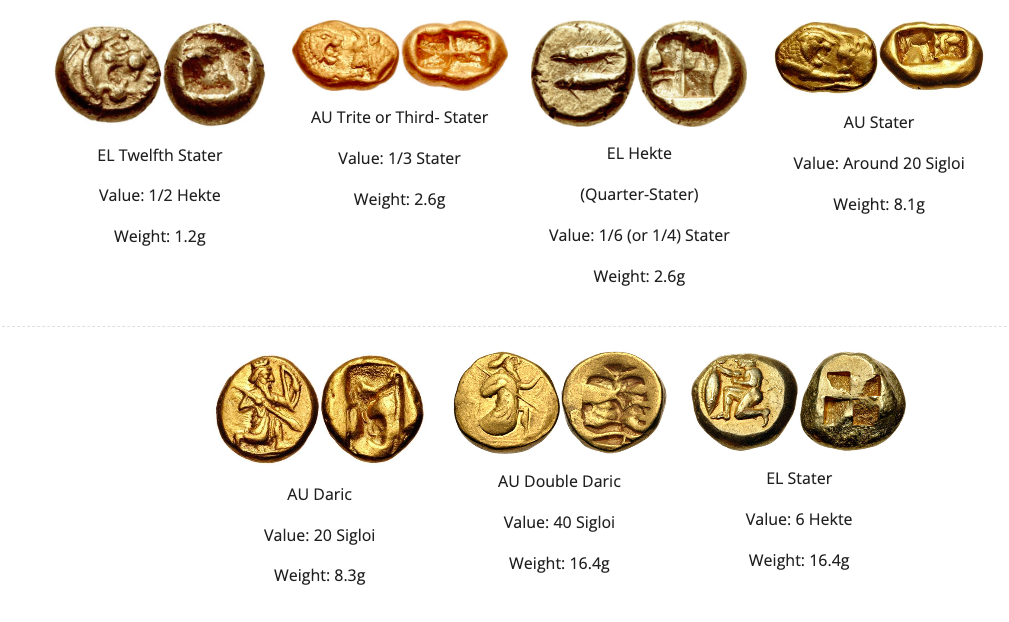Greek coinage have captivated historians and collectors alike for millennia. The rich history and culture of Greece are reflected in these antiquities, which also shed light on the evolution of money and trade in the pre-modern era. The various coins that were used over time reflect the most fascinating features of Greek coins. These coins, which ranged in size from the tiny Obol to the great Dekadrachm, were more than just objects made of metal; they also served as symbols of the riches and power that governed the ancient Greek economy. The intriguing world of Greek coin denominations, their significance in weights, and their history will all be covered in this essay.
For the majority of Greece, the main units of measure were the Obol and the Drachma. Other states used the bronze Onkia as a unit of measure, where one Obol equals around twelve Onkia. Greek coins were minted in bronze, silver, and gold. Similar to other ancient coins, they were also struck using alloys like billon and electrum. Electrum is gold's natural state, consisting of about 30-50% silver and the rest gold and tin. Billon, on the other hand, is man-made and contains about 40% silver and the rest bronze. Due to inflation, some denominations fluctuated and were eventually abandoned. Some even changed metals or were produced in different metals in various regions. The weight and metal purity of coins depended on the region and the time period they were struck. Some Greek civilizations often experienced severe inflation resulting in silver coins being reduced to low purity or bronze.
Bronze coinage circulated in forms that were severely devalued, as a small silver coin had the same value as an enormous bronze issue. Such bronze coins are labeled with Æ followed by the millimeter size of their diameter. For coins struck in the Mediterranean region, however, it is common to call them by their commercial names. Greek silver coinage is split up into two sections. The main unit in all Greek coinage (separate from Asia minor) is the Drachm. Coins are still valued depending on Onkia or Obols, but the Drachm is considered the perfect unit in trade, as it was the perfect weight and value. Silver denominations are made up into multiples of the Drachm, or fractionals of it. Coins are often labeled by Greek suffixes like hemi-, di-, tri-, tetra-, etc. Unlike silver issues, gold coins are based purely in value from their silver counterparts. The very first gold coins were minted by the Lydians. These coins were crudely cast and struck of varying fractional weights. The very first gold coin invented was the Stater-Hekte, with its fractional denominations being valued at one Hekte. Later on, the Persians used the Daric (named after king Darius) as their main gold coin. The Daric was similar in size and weight to the silver Siglos. Until the archaic civilizations mastered refining silver, gold was worth the same or less than its silver counterparts. The Persians used the gold Daric to strike multiple denominations of the gold Stater in their provinces as well. It wasn't until the Peloponnesian war that gold coins began circulating immensely in the Greek mainland. Athens and Sicily were one of the first city states to issue their gold coins to pay duties and costs of damage caused by the war. As the story goes, there existed a golden statue flanking the Athenian Acropolis of Nike that was melted down and used to strike coins resembling the owl type.
Each region had a set standard of coinage that facilitated trade and commerce. Some regions, such as Ptolemaia, had a separate standard, causing monetary isolation. Consequently, it was challenging to trade with local coins since they were worth a fraction compared to heavier coins of the "same" denomination. The most common standard in coinage was the Attic weight, consisting of 17.2 strict grams of pure silver. This was the most trusted standard in coinage, and coins minted using this standard were circulated more. Numismatists must keep in mind that all stated weights are dependent on the most popular system of weight at that time. For instance, other standards may have the same denominations weighing more or less if they are set by a different standard. Coins of subsequent standards will be explored in depth. It is often challenging to know the exact denomination of a coin without first knowing which weights were used in which region.
A Quick Introduction to Weight Standards
In numerous ancient Greek city states, coins of differing weights were in use. Every area had a predetermined standard that became the foundation for all other denominations. At first, weights were used to give each denomination a value. As technology progressed, mints tried to increase the value of their basic coinage by slightly reducing the weight and lowering the purity. This occasionally caused the economy to experience catastrophic inflation due to coins of impure exchange. The concept of impure exchange is heavily impacted by inflation; where the value stated in a coin is not the actual value (ie. a Drachm being made of less than a Drachm on silver). Each base currency may have been designed to circulate in a small or vast territory depending on the state or empire from which the weight standard descended. Typically, a heavier weight was employed for local use and a standard weight for trade. Regions that only published a single, isolated standard were plummeted into a process known as economic isolation. Economic Isolation is a result of the difficulty in valuing currency on the open market. In order to ensure that all coins could be valued equally, Alexander the Great only permitted the use of the Attic standard across his realm. Depending on where it was struck, many countries, including those who minted the Stater denomination, produced Staters that might weigh as little as 4 grams or as much as 16 grams. Examples from the modern era include the US dollar and the Canadian dollar, which have the same name but somewhat different exchange rates. Theoretically, the value and weight of every coin should be the same, although this is frequently not the case. Accurate planchet weighing was usually a problem due to technological limitations, leading to variations of a denomination that are "heavy" or "light". In the Roman empire, “heavy” or “light” coins were issued to combat inflation rates. Additionally, the thickness and weight of the coins decreased due to substantial wear. If a coin is sufficiently worn down, it might lose up to 3 grams of weight. To correctly identify a coin, it is essential to know its weight standards and denominations even if the coin is heavily worn
Standards are calculated on their base denomination. If the base denomination is a Stater, the Stater will have the set weight and depending on the weight of a coin of the same standard ( and it will always equal that base). Such as the Tetradrachms minted in Thrace, Abdera. They are commonly minted of the reduced Chian standard at 14.82g. The coin is worn a bit and corroded which will change the weight of the coin. Later coins of Abdera were switched to the Persian standard at 10.23g per Tetradrachm. Fractional denominations are a bit different. It is challenging to calculate the smallest of coins because the earliest examples are hyper inflated. This means a 1/48th Stater may not equal 1/48 in value but perhaps something less than that. An Ionian coin minted under the Milesian standard is classified as a Lydian Hekte or 1/12 Stater. The Milesian standard is 14.2g per electrum Stater, therefore, the 1/12th Stater should weigh roughly 1.18-1.20g. Commonly, these coins weigh about 1.15g. The simple miscalculation makes the coin devalued by nearly 0.24g lighter when compared to a Stater. These standard errors were exposed 4th century BC, and because of the increasing weight technology, it effectively brought an end to the fractional base system of coinage.
Region/Standard Base Base Weight Standard (per.)
Achaean Stater 8.9g
Anginetan Stater 12.2g
Attic Tetradrachm 17.2g
Chian Tetradrachm 15.6g
Cistophoric Tetradrachm 12.6g
Corinthian Stater 8.6g
Euboean Stater (Post Attic) 17.2g
Milesian Stater 14.2g
Parian-Thasian Stater 10.0g
Persian Siglos/Tetradrachm 8.35-8.55g/10.23g
Phokaic EL Stater 16.1g
Phoenician Shekel/Tetradrachm 7.0g/14.2g
Pseudo-Campanian Stater 7.5g
Ptolemaic Tetradrachm 14.26/17.2
Rhodian Tetradrachm (Post Chian) 13.4g
Samian Tetradrachm 13.1g
During difficult times or a change in authority, coins often underwent a reduction in weight and purity. When empires conquered other nations, they sometimes allowed them to mint their own coins to a standard that was approved by the conquering empire. In many cases, coins were made lighter or were minted using different metals to meet the standards set by the ruling authority. However, during times of severe depression or inflation, coins were often made lighter to reflect their reduced value in the market. This had an impact on the value of goods in the economy and eroded public confidence in the purchasing power of their money. The series of coins minted in Calabria Tarentum is an example of how coins were issued in varying weights under different rulers during different authoritarian periods.
A Typal standard refers to a series of coins minted under a single authority that is widely circulated in various regions. The Attic standard is an example of such a standard, as it was prevalent in almost every part of Greece. When Alexander the Great conquered his empire, he introduced coins of identical type and weight to be used in all corners of his vast kingdom. All denominations of coins were uniform, demonstrating an unprecedented level of quality and consistency never seen before in Greece. The early Staters of Corinth, featuring Athena and Pegasus, were also widely circulated and imitated. Nearly every region in the Greek mainland produced a Stater type that resembled those minted in Corinth under the Corinthian standard.
An Inherited standard are coinage types issued by a usurping power. A perfect example of an inherited standard are the Persian coin types minted under Persian satrapy's (provinces). These coins were minted under the Persian ruling authority, with Persian kings represented but with the standard of the coins kept. The coins minted under the brief Persian authority of Caria were such examples. Persian Satraps issued coins of the Chian standard with Persian figures being represented on the obverse and reverse of their coins. The coins were minted using the existing standard of their region but have a mixed representation of Greek and Persian ideology. The legend is in Greek, showing Greek idols, but the style of the coin and shape resembles the Persic style.
Article by: Colby J. Abele
The denominations listed below are based on the most abundantly issued standard. Listed weights do not apply for all types of the same denomination. Many coins of the same type were also issued in various standards depending on the time of issue.










